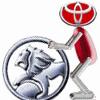-
Latest Postings
-
-
1
Anyone know the ZZE122R 5sp manual gearbox code?
C52. Is yours South-African or Jap-built? -
11
Whats the Difference between a 7a-fe and a 4a-fe motor?
O cabeçote do 7afe é compatível com o motor 4afe? -
0
Diesel injector pump
Hi, I have a 93 Toyota Landcruiser 1HZ (470K) which my mechanic has said needs a new diesel injector pump. Been doing some online searching and wonder has anyone tried the replacement pumps available from China? Cheers & Beers Noel -
6
Toyota prado 2018 Rattling noise?
Hi all I have a 2018 Prado making the same noise and we believe it is coming from the fire wall area We took it to a mechanic and he put zip ties on our tyre well guard which made not one bit of difference Would love to know how to fix it as it is getting really bad and is louder than the one in the video -
1
Anyone know the ZZE122R 5sp manual gearbox code?
Simple question but I can't find the answer anywhere so far - what's the gearbox code for the 5sp manual in the ZZE122R? I'm trying to work out the ratios of the box in my car, and I can find lots of internet sites talking about various 'C' series boxes, but nothing saying what the Australian ZZE122R 5sp box was. The sticker inside the passenger door says 'TRANS/AXLE A860 G770' but I can't find anything on the web that matches those codes to the gearbox codes everyone talks about. Can anyone help a newb? -
0
New member with ZZE122R Corolla in Sydney
Hey, new member - just bought my elderly mother's 2005 ZZE122R with the 5sp manual to take out to western NSW. It's the car that never dies so I'm going to show it some love and attention. Already finding lots of great info on the forums - looking forward to the experience! -
0
A Toyota Prado has been stolen last night from garage
Plate No. XA 366P, if found please inform SA police would appreciate any information/ suggestions please. personal number 0452566250 sharmin -
0
Wanted - 2010 Toyota Camry Altise Sedan Sun Visor
I want to buy a driver side sun visor suitable for my 2010 Toyota Camry Altise sedan. Alternatively, is there some kind soul who can tell me what other models of Camry sun visors will fit my vehicle. -
1
Vehicle tool kit
Just go to the wreckers or search for someone wrecking one, my cousin up in Lowanna way would probably have one
-





Recommended Posts
Join the conversation
You can post now and register later. If you have an account, sign in now to post with your account.